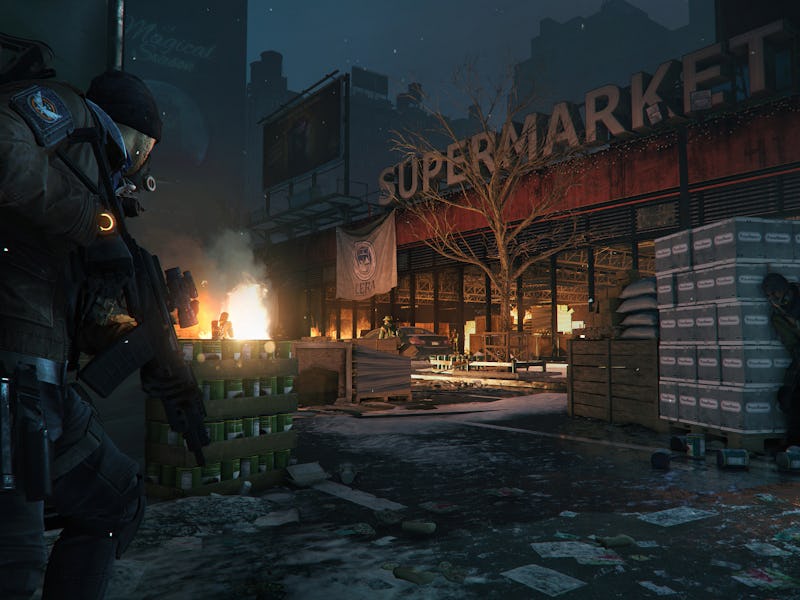Here's Why Player Trading Doesn't Exist in Games Like 'Destiny' and 'The Division'
It's simply a matter of game design.

In giant massively multiplayer online worlds, you’d expect player trading to be a thing — especially when it comes down to maintaining a good, interactive economy among the player base. It’s a system that has been present in MMOs like World of Warcraft and Star Wars: The Old Republic for years, allowing players to manipulate prices and sell items to each other for profit. And that’s exactly why we haven’t seen it pop up in new hybrid MMOs like The Division and Destiny; they just aren’t ready for it quite yet.
Realistically, player trading is a very complicated and intricate system to put into play — especially when a large portion of your player base is new to an MMO-type game. Not only does it require loads of management from the developers’ side of the spectrum to keep a fair economy going, but also it forces them to develop their loot system in a way to counteract the loopholes that player trading allows.
In games like Destiny and The Division, loot is one of the top priorities for players — it allows you to enhance your character’s abilities, increase attributes like health and stamina, and keep you looking like an absolute badass. As such, developers tend to make it one of the most important parts of their games. But what’s the difference between these new hybrid MMOs (e.g., The Division) and the established online MMOs (e.g., World of Warcraft)? The developers behind the hybrid MMOs don’t know how to combat the many challenges a player trading system would bring to the table, in regard to the loot-focused progression they’ve made the core of their game.
Take Destiny, for example, where loot helps you progress through the game and complete the toughest challenges. Obviously, there are certain pieces of armor or specific weapons that out-perform others, and when you first start playing, those items are your end goal — you’re playing Destiny to find them for your character. In order to do so, you’re going to level up your character and you’re going to obtain gear that lets you take on the hardest challenges the game has to offer — all in the hope of obtaining that specific weapon you’ve been working toward. It could take days; it could take weeks; hell, it could take years — and that’s the point. It keeps you engaged, it keeps you playing and it keeps you interested.
Red Death, one of the most sought-after weapons in 'Destiny'.
Imagine your best friend has that specific weapon and just hands it over to you through a player trading system, if it were implemented. It basically eliminates the hours you’d be putting in to get it yourself. And once you’ve completed your end goal thanks to your friend? Well, odds are that you’re going to put the game down until some new content comes out — and therein lies the problem developers of Destiny and The Division are facing.
Since their games are based entirely around loot and the opportunities that allow you to obtain it, adding player trading could potentially strip a majority of the experience away from their players, which is, obviously, not something they would want to do. Sure, it would address the frustration that many players face thanks to the randomly generated loot drops —like receiving the same gun from a Destiny raid six weeks in a row — but at the cost of the experience they’ve created for the player.
But why not get the best of both worlds?
At this point, it’s honestly surprising we haven’t seen a player binding system, similar to the one in traditional MMOs, present in Destiny or The Division. Typically known as the binding system, it prevents players from trading high-end or specific pieces of loot (as determined by the developers) once they are either picked up or equipped by the player. This allows the development team to then isolate rare or top-tier items so that players can obtain them only from end-game activities, effectively controlling which game components players can trade between each other.
Now, I don’t know all the specifics behind implementing a system like this into Destiny or The Division, but it’s certainly a system that could combat both the players’ collective desire for a trading system and the developers’ need to control the loot that can be traded, if added to each game. The only real concern is the amount of loot in each of the games, namely because only certain types of gear are sought after by players, which would limit a player trading systems effectiveness. While we don’t know much about the loot drops in The Division quite yet, we do know the most sought-after pieces of gear in Destiny. They’re largely pieces that Bungie certainly wouldn’t allow players to trade among themselves due to their place within the game — which could become an issue for most players interested in trading in the first place.
Either way, it’s going to be interesting to see if (and how) player trading is going to be implemented in the new genre of hybrid MMOs for the current console generation, led by Destiny and The Division. But, at the moment, it doesn’t look like a system we’ll be seeing anytime soon, despite popular demand.